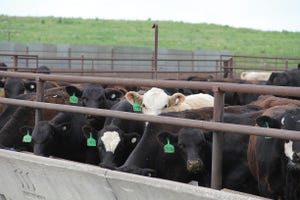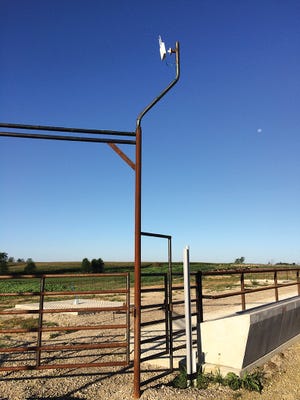Applying today’s technology to age-old challenges in practicing veterinary medicine is leading these veterinarians into uncharted territory and unlimited possibilities.
March 3, 2015

"Doc, she’s walking kinda gimpy on her left hind leg and it looks swollen a bit… and I’m not sure, but she might be bloated. You reckon I should bring this old cow in to see you or wait and see what happens?”
With all of today’s iDevices in everyone’s hands, it’s easy enough to ask the rancher to send a photo or even a video of “this old cow” to help you, his veterinarian, decide whether she needs treatment and how urgently. But should you charge a fee for this? How much? And will the client understand your virtual assessment needs to be monetized just as it would be if you were standing beside him in the pen?
Ask Arn Anderson, DVM, of the Cross Timbers Veterinary Hospital in Bowie, Texas. Serving bovine, equine and small animal clients, Cross Timbers is quickly becoming a model practice for tackling both the opportunities and challenges of incorporating telemedicine into a rural, veterinary practice.
“Everyone uses a smartphone or an iPad,” he says. “We combine these with FaceTime and Skype and can share information between clients and the clinic or between DVMs. It allows us to make a decision and get treatment started before we make it out to the ranch.”

Arn Anderson, DVM
“Between DVMs, this technology allows us to mentor younger veterinarians in rural environments and allows us to share cases and get second opinions easier and faster. It is better medicine,” Dr. Anderson affirms. “We have used FaceTime in surgeries at our outlying clinic (about an hour and a half away) where we placed a young associate. All you need is a technician to hold the iPad so we can see what’s going on, if they run into difficulty or just want one of us to provide feedback. The cool thing about FaceTime is it is live."
This technology never replaces hands-on examination, but it does allow us to get the ball moving. We charge to view these videos and to answer email. But clients appreciate this service and the ability to get a rapid response.”
Dr. Anderson and the other two full-time veterinarians in the practice are also utilizing technology to send electrocardiograms (EKGs), radiology images, ultrasound scans and photos of skin cancers, among other things, to board-certified specialists in Dallas, Amarillo and other cities far from the rolling plains of North Texas.
More expertise
“Rural vets are in a position to use this tech and really increase the scope and sophistication of their practice,” Dr. Anderson explains. “Sending pictures and videos to the diagnostic lab, along with samples, increases the chance of a successful diagnosis.”
While Dr. Anderson himself is board certified in beef cattle practice, he points out that many rural veterinarians are not board certified.
“We have used technology to involve dermatologists, ophthalmologists, theriogenologists and cardiologists in our practice. It raises the bar of possibilities and expectations. The limitations really just center around your willingness to try new things. I believe this trend to be increasing as we learn all the adaptations and possibilities,” he adds.
“The problem will always be how to be fairly compensated. As vets, we are our own worst enemy because we always feel guilty about charging for our services. The reality is, our clients don’t have a problem with it.”
Not crossing over the line
Other challenges in providing veterinary telemedicine services include being diligent to adhere to veterinary client-patient relationship (VCPR) requirements as well as state licensing regulations. In fact, the American Veterinary Medical Association (AVMA) Model Veterinary Practice Act specifically emphasizes:
“…a VCPR requires the veterinarian to examine the patient, it cannot be adequately established by telephonic or other electronic means (i.e., via telemedicine) alone. However, once established, a VCPR may be able to be maintained between medically necessary examinations via telephone or other types of consultations.”
So far, this isn’t a problem for Dr. Anderson’s practice, which requires a veterinarian be on the ranch four times a year in order to prescribe medication, as an example. However, Mark Spire, DVM, technical services manager for Merck Animal Health, has spent years studying the possibilities of veterinary telemedicine and says there is a real need to update policies in order to keep up with the light-speed evolution of technology and its subsequent adoption by the industry.

BEEF Seedstock 100
Looking for a new seedstock provider? Use our BEEF Seedstock 100 listing to find the largest bull sellers in the U.S. Browse the Seedstock 100 list here.
“As we get more sophisticated in telemetry and distance medicine, the fewer clients you may have in proximity,” Dr. Spire explains. “They will likely be scattered over greater distances, which makes it more difficult to practice because you have to have a license in each state and meet the criteria for a valid vet-client relationship, available for follow up, record keeping system, etc. As the nuances evolve over the years, it will change the way we practice medicine”.
Outdated policies?
“One of the biggest hamstrings is parochial interests. We need greater flexibility from state veterinary boards to allow it and flexibility from the AVMA, which put restraints on the electronic practice of veterinary medicine. We need these organizations to be open to the concept and there is also some work to be done at the federal level—airspace availability, FCC restrictions, that sort of thing.
“We have so many tools coming online, like the REDI system, Whisper stethoscope technology, ear tags that record temperature and movement, chute side drug tests, BVD [bovine viral diarrhea] tests, etc.,” says Dr. Spire. “The technology we have is rapidly changing, both chute side and distance. The difficulty is in the application. These things will change the way practices operate. Not only do practices have to figure out how to charge for them, they will also need to adopt them into their record keeping systems.
“There is potential to build alliances among practices with a central data recovery facility on a fee basis,” Dr. Spire says. “But, our technological advances have run up against the stonewall of bureaucracy.”
No doubt, unforeseen legal issues may arise as veterinarians navigate uncharted territory. However, one doesn’t need a crystal ball to anticipate the rising adoption of veterinary telemedicine simply because the possibilities for improvement in diagnostics, treatment, animal welfare, judicious use of antimicrobials, and practice management are so tantalizing.
Tools and telemetry
The REDI system Dr. Spire alluded to is a system designed by Dan Goehl, DVM, and Brad White, DVM, who founded a research and data management enterprise called Professional Beef Services (PBS). Dr. Goehl operates the Canton Veterinary Clinic in northeast Missouri and Dr. White is on faculty at Kansas State University.

Dan Goehl, DVM
REDI stands for remote early disease identification and was designed to identify bovine respiratory disease (BRD) through real-time location monitoring of calf behavior paired with a disease classification engine. REDI has been in development for three years, being tested in two beta feedyards as well as a PBS-run yard. While it’s not ready for commercialization just yet, the results to date have been eye-opening.
According to Dr. Goehl, REDI finds 55 percent of sick calves a full two days before a trained observer can pick up on signs of illness. Not only that, by identifying subtle changes in behaviors not normally recognized or witnessed by pen riders, REDI also has the capability to find subclinical cases of BRD that might otherwise go untreated.
Subscribe now to Cow-Calf Weekly to get the latest industry research and information in your inbox every Friday!
“Behavior is masked when you are in the pen with them or during times of high social pressure (feeding, etc.), and obviously when you leave the pen, behavior reverts back to what it was previous to the time of high pressure,” Dr. Goehl explains. “Our system picks up subtle differences in behavior and works 24 hours monitoring cattle versus the 30 minutes you might be with them. When treatment is needed, every hour counts.”
The REDI system utilizes active electronic identification (EID) ear tags and readers placed strategically around a pen continuously triangulate and track cattle movement (proximity to other animals, trips to the feed bunk and water, lying down, etc.). It feeds that data back into a program they developed using algorithms for various measurements which then are used to create decision trees.
However, identifying BRD may only be the tip of the iceberg for this type of technology.
“BRD is the low-hanging fruit and the most important disease complex in confined cattle,” Dr. Goehl says. “This technology can also be adapted to other disease processes like lameness and digestive problems, and even outside applications such as inventory systems or sorting custom cattle into the right pens.”
Computerized stethoscope
On a smaller scale, digital tools like the Whisper veterinary stethoscope (from Geissler Technologies) also show great potential to lower overall disease costs and more accurately identify and diagnose sick cattle.
Whisper is a diagnostic stethoscope that records lung sounds in eight seconds and utilizes a system of lung scores (1 to 5) to more precisely assess lung disease associated with BRD. Differences in lung scores can indicate the initial severity of illness, as well as help veterinarians monitor whether or not an animal is getting better during the course of treatment.
It can also be highly useful in diagnosis. For example, when an animal is pulled for BRD but turns out to have a low lung score, it could indicate the steer has another health problem, instead requiring very different treatment. Again, this technology can help facilitate judicious use of antimicrobials.
Pull the blinking light
Another interesting digital tool being introduced to animal health providers is a WiFi enabled eartag system that detects fever. One example is the Fever Tag (from AgMedix) which is connected to a probe that slides into the ear canal to monitor the animal’s temperature for a set period of time. Measurements are taken every 15 minutes and if a temperature exceeds 103.6 degrees Fahrenheit, an alarm is triggered. The tag is equipped with an LED light that will flash so you don’t even need to be near your computer to identify the possibly sick calf.
Early intervention, less stress and handling and lower labor costs are all potential advantages of this technology. Obviously, the remote monitoring feature fits into all types of telemedicine scenarios.
 Whatever technology is utilized, one line of thinking is that by identifying sick cattle sooner, veterinarians might also be able to use more discretion in what antibiotics are used to treat individual animals. In other words, when treatment is initiated early in the disease, there may, in some cases, be an opportunity to use older and less expensive antibiotics rather than having to pull out the newest, most powerful drugs used when the disease is more progressed. Or, the total number of doses of whatever medication given may be reduced for multiple reasons.
Whatever technology is utilized, one line of thinking is that by identifying sick cattle sooner, veterinarians might also be able to use more discretion in what antibiotics are used to treat individual animals. In other words, when treatment is initiated early in the disease, there may, in some cases, be an opportunity to use older and less expensive antibiotics rather than having to pull out the newest, most powerful drugs used when the disease is more progressed. Or, the total number of doses of whatever medication given may be reduced for multiple reasons.
Digital necropsy
While it’s not all that new, particularly in Canada, the use of digital imaging for clinical and postmortem findings in feedlots is another avenue of veterinary telemedicine that particularly benefits remote yards where a veterinarian may not be able to be onsite daily.
Although feedlots are the target clientele of companies offering digital necropsy services, it’s not hard to see how cow-calf producers in remote areas could also benefit if their vet is willing to work with them.
Many ranchers and their hired hands are capable of performing (or being trained to perform) at least a rudimentary necropsy, which if FaceTimed or recorded and sent to their veterinarian and/or diagnostic lab, would allow for faster and more accurate findings that could also help the rancher treat other affected animals before the vet can get there.
Getting started
So if you have not yet incorporated some form of veterinary telemedicine into your practice (beyond email) what type of investment does it take to get started? Dr. Anderson says not much.
“The initial investment is minimal,” he says. “Start with your iPhone, download apps and get started. You can photograph X-rays, record EKGs and video neuro cases right away. We have purchased digital X-ray machines, EKGs that are on the phone and apps for all kinds of things.
 “In a rural practice with big distances and large animal numbers, I see this as a first line of prevention and treatment. It allows us to triage cases, to further pursue cases and to get additional opinions and achieve more accurate diagnosis. It should never replace hands-on exam and evaluation.
“In a rural practice with big distances and large animal numbers, I see this as a first line of prevention and treatment. It allows us to triage cases, to further pursue cases and to get additional opinions and achieve more accurate diagnosis. It should never replace hands-on exam and evaluation.
“But with more of the remote ranches and clinics being understaffed nowadays, this can save animals from some pain and improve our time efficiency,” Dr. Anderson says. “We need to train our clients, develop our professional relationships and practice better medicine.”Beef, pork, poultry, fish and seafood—no meat protein is immune from public scrutiny, nor should it be. Food production should be scrutinized and transparent. But, for the public to scrutinize food and how it is produced, it is absolutely imperative that it’s done through an informed, objective lens.
What does genomic and biotechnology and the consumer have to do with best-practice veterinary medicine? I am more convinced than ever before that veterinarians can be the linchpin to connect the consumer to production with objective, transparent information. No doubt, moving the needle of acceptability through one-to-one conversations compared to an appearance on Dr. Oz or Oprah’s couch is like comparing our old country telephone “party lines” to Facebook!
As an urban or rural progressive practitioner, you have instant integrity and a strong voice. Those of us with a much smaller voice encourage you to use it.
You might also like:
Experts say ranching done right improves the environment and wildlife habitat
Is sexed semen the next reproductive standard?
Breathtaking photos of winter on the ranch
Bale grazing lets cows feed themselves
You May Also Like



